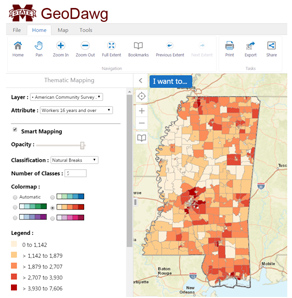New user-friendly web tool brings power of GIS to the public
Contact: James Carskadon
STARKVILLE, Miss.— The Geosystems Research Institute (GRI) at Mississippi State University has released a new web application, “GeoDawg,” that gives Mississippians the ability to easily use the capabilities of a powerful geographic information system (GIS).
GeoDawg is a simple, yet sophisticated, geographic information system that allows users to view high-resolution aerial imagery, find elevations anywhere in Mississippi, create and share maps with others, among many other uses.
The software was developed as a means to publicly share a large collection of GIS data acquired through grants from the state of Mississippi over the past several years.
“There is a relatively long learning curve to use GIS software currently,” Scott Samson, an extension professor with GRI, said. “GeoDawg shortens the learning curve by processing and managing data internally and providing commonly used tools found in GIS through a user-friendly interface.”
GeoDawg provides a collection of tools to access a list of map layers, search the Internet for compatible GIS servers or create maps on top of base maps. Members of the public can use text, points, lines and polygons to highlight and describe features on the maps.
Samson believes people across Mississippi will find many uses for GeoDawg. For example, local governments can use GeoDawg to create maps to show potential sites for public and private projects. Farmers can measure rainfall over specific periods of time in local areas. Also, maps can be compiled and distributed quickly for use during emergency situations.
“I hope to hear from users regarding their applications of GeoDawg,” Samson said. “There are no limits to the creative mind.”
GeoDawg was designed with portability and real-time data in mind. The application is compatible with all computer operating systems, as well as desktop and laptop computers and all smartphones. Real-time GPS location of the user’s position is available when GeoDawg is taken into the field. Weather warnings and precipitation accumulation map layers are real-time or near real-time. A GeoDawg user can quickly obtain an estimate of precipitation accumulation over the past 1, 3, 6, 12, 24, 48 and 72 hours.
Although GeoDawg is easy to use, a user manual is available and may be downloaded from the GeoDawg website. The illustrated manual provides instructions on using GeoDawg’s data and tools.
Users can quickly zoom to a Mississippi county of interest with the aid of a geographic bookmark for each of the 82 counties. GeoDawg users also may upload digital maps from sources such as GPS receivers and Google Earth. Ground elevations can be displayed at a point or along a transect for much of Mississippi. A map coordinate or an estimated postal address can also be displayed at any point on the map.
There are a variety of ways for GeoDawg users to interact with map layers. Multi-colored maps can be created showing the distribution of a map layer attribute (for example, population count), generate basic statistics of an attribute, display all attributes for a user-selected county and add map layers from other GIS servers around the world. Completed maps may be printed, saved as graphic files or sent to others through a variety of social media platforms.
GeoDawg can be found at https://geoproject.hpc.msstate.edu/geodawg. For additional information, contact Samson at ssamson@gri.msstate.edu.
MSU is Mississippi’s leading university, available online at www.msstate.edu.
